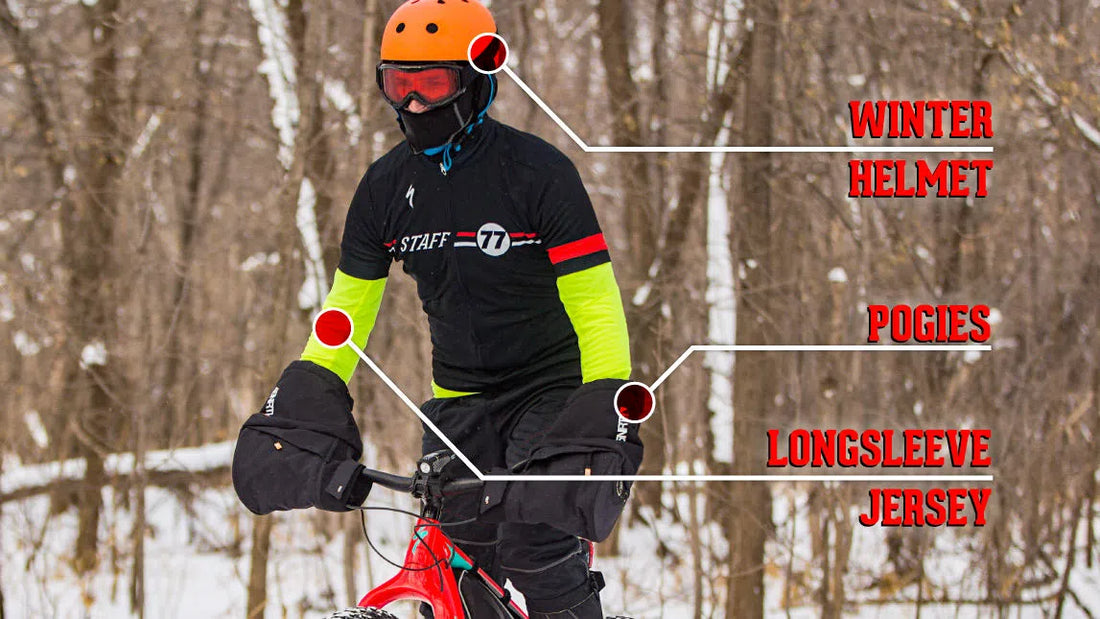
Conseils pour rouler en deux roues en hivers
Share
Conseils pour le Vélo d'Hiver : Restez au Chaud et Performant Même en Conditions Extrêmes
L'hiver ne doit pas être un obstacle à vos aventures à vélo, à condition d’être bien préparé. Le fat bike en hiver peut être une expérience incroyable, mais cela nécessite les bons équipements, une préparation adéquate et quelques ajustements spécifiques. Voici un guide complet pour vous aider à profiter de votre vélo électrique en hiver, tout en garantissant votre confort et sécurité.
1. S'habiller pour réussir en vélo d'hiver
Rien ne sert d'opter pour des vêtements trop chauds dès le départ. Lorsque vous pratiquez le fat biking en hiver, votre corps produira une quantité importante de chaleur, et il est crucial que vos couches de vêtements soient adaptées pour vous garder au sec tout en restant protégés des éléments. Au début de votre sortie, vous devriez ressentir une légère fraîcheur, mais vous vous réchaufferez rapidement au fur et à mesure de votre activité. Cette approche empêche la transpiration excessive, ce qui peut rendre vos couches humides et donc vous faire avoir froid. En outre, il est toujours sage d’emporter des couches supplémentaires au cas où vous sous-estimiez les températures ou si vous avez un souci mécanique et devez attendre pour des réparations.
2. Ajuster la pression des pneus
Avant de partir en balade, vérifiez la pression de vos pneus. Une pression plus basse est idéale pour les conditions de neige molle, tandis qu'une pression plus élevée est préférable pour les terrains plus compacts. N’hésitez pas à expérimenter pour trouver la pression qui convient le mieux à votre style de conduite et aux conditions spécifiques du moment.
3. Ajuster la hauteur de votre selle
Rouler sur la neige et la glace demande une approche différente de celle du gravier ou du bitume. Abaisser la selle de votre vélo d'hiver permet de positionner votre centre de gravité plus bas et plus à l'arrière. Cela réduit la pression sur le pneu avant et vous aide à garder un meilleur contrôle, notamment dans les conditions glacées. Cet ajustement vous offrira une conduite plus stable et sécurisée sur les terrains difficiles.
4. Commencez à pédaler doucement et lentement
Lorsque vous commencez à rouler sur la glace ou la neige compactée, positionnez votre corps en arrière pour concentrer le poids sur la roue arrière. Ensuite, commencez à pédaler doucement et de manière fluide. Si vous appuyez trop fort sur les pédales d'un coup, il y a un risque que votre roue arrière patine. Pédalez lentement et maintenez votre poids bien réparti. À mesure que vous gagnez en vitesse, ajustez continuellement votre position pour rester centré sur le sentier.
5. Modérez l'utilisation des freins
Comme pour le pédalage, il est essentiel de freiner de manière douce et progressive. En roulant sur la neige, il est souvent difficile de discerner ce qui se cache dessous : de la boue, de la glace, de la neige fondue ? Une conduite douce sur les freins vous permet de mieux ressentir le terrain et de vous adapter à sa consistance. Un freinage brutal et soudain, en revanche, peut facilement provoquer une perte de contrôle, voire une chute. Prenez votre temps pour ralentir, surtout sur des surfaces instables.
Conclusion : Préparez-vous pour l'hiver avec votre vélo électrique
Les balades en hiver avec votre vélo électrique peuvent être incroyablement agréables et enrichissantes si vous êtes bien préparé. En suivant ces conseils pratiques, vous serez en mesure de profiter des conditions hivernales tout en garantissant votre sécurité et en optimisant les performances de votre vélo.
Chez [Nom de votre magasin de vélos électriques], nous avons une gamme de vélos électriques adaptés à toutes les conditions, y compris des modèles de fat bikes spécialement conçus pour l'hiver. Que vous soyez un cycliste urbain ou un aventurier passionné, nos vélos vous offriront confort et performance tout au long de la saison hivernale.
N’oubliez pas que l’entretien de votre vélo est aussi essentiel pendant l’hiver. Si vous avez des questions sur l’équipement, l’entretien ou les accessoires d’hiver pour vélos électriques, contactez-nous, et nous serons ravis de vous guider dans vos choix !
Pourquoi choisir notre boutique ?
- Vélos électriques adaptés à l'hiver : Pour un confort et une performance optimaux.
- Entretien et réparations : Nous vous aidons à garder votre vélo en parfait état pour toute aventure hivernale.
Préparez-vous pour l'hiver et roulez avec style, sécurité et confort !